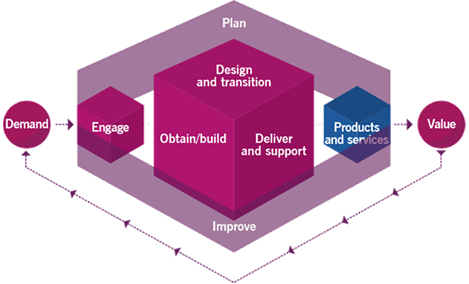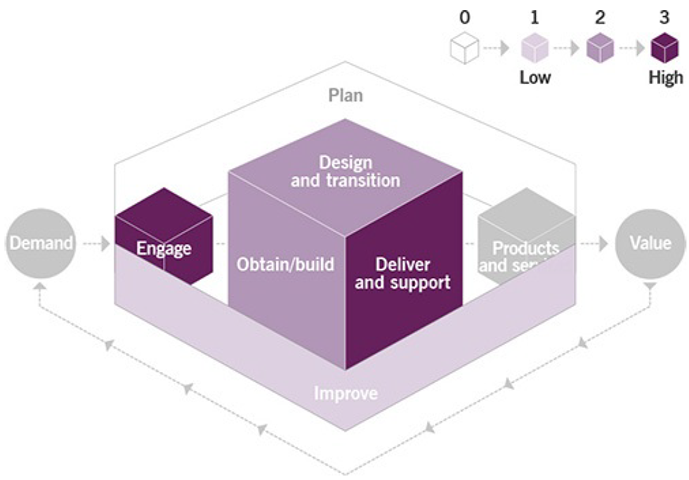Delivery of ITIL Services Course Monster Blog ITIL 4 - %

Almost every entity, be it a government agency, hospital, or food chain, exists to serve its clients. However, how they provide these services varies based on factors such as their operating conditions, the needs of customers and stakeholders, available resources, cultural influences and ITIL.
In the digital era, technology-focused service delivery is becoming the go-to model for organizations of all sizes. According to UNCTAD, in 2020, the export of digitally delivered services grew to almost 64% of total service exports, largely due to the impact of the COVID-19 pandemic.
The ITIL framework, which has been around for the past 30 years, remains a valuable tool that organizations can use to guide the delivery of technology-related services. In this article, we will explore how organizations can utilize the ITIL 4 framework to enhance their service delivery efforts, resulting in benefits for both the organization and its customers.
Want to know more about ITIL? Visit our ITIL courses now.
What is Service Delivery?
Service delivery is a subset of service management and is defined by the Cambridge Dictionary as the process of providing a service to customers. It is typically considered the final stage in which a service is made available to customers who request it after being developed and made operational.
The success of service delivery is often evaluated from the customer’s point of view, specifically whether they are pleased with the service they received and the efforts put forth by the provider in delivering it.
- It’s clear that a service that performs poorly, such as with frequent login failures, slow responses, or a poorly designed user interface, will not meet expectations.
- Even if the service is of good quality, if the provider is inadequate in delivering it, such as with delays, poor customer service, or incorrect billing, the customer’s perception will remain negative.
Achieving successful service delivery requires an understanding of the necessary skills and the required quantity of each resource. The ITIL 4 CDS publication states that all four dimensions of service management (organization and people, information and technology, partners and suppliers, and value streams and processes) must be taken into account holistically to determine the appropriate resource needs in terms of both quantity and quality.
Individuals involved in service delivery, particularly those who interact directly with customers, such as the service desk, must be equipped with the necessary tools and information to effectively meet customer requirements and meet established service goals. They must also be motivated and led properly, within a culture that prioritizes services and customers.
- Automation should be implemented for repetitive manual tasks to optimize them and achieve faster delivery times and improved quality.
- When working with third-party vendors or partners, contracts and agreements must establish an approach that prioritizes customer satisfaction.
- Value streams and processes should be consistently evaluated and optimized to prevent them from hindering efforts to effectively meet customer needs.
The ITIL 4 Service Value Chain
ITIL 4 introduces the concept of the service value chain, which is the central component of the service value system.
The service value chain is an operating model that outlines a series of interrelated activities necessary to respond to customer demand and realize value through the creation and management of products and services. This specific combination of activities and accompanying practices creates a value stream that begins with a request and culminates in value delivered through the provision of products and services.
For instance, a value stream relating to access to a SharePoint folder might start with the Engage activity, where the user requests access through the Service Desk via email or by submitting a request through an ITSM tool. The Service Desk Agent then fulfills the access request through the Deliver and Support activity.

The Deliver and Support activity is the key component of service delivery in the Service Value Chain. Its purpose is to ensure that services are delivered and supported by agreed specifications and stakeholder expectations.
The Deliver and Support activity receives inputs from other activities within the Service Value Chain, including:
- New and changed products and services provided by Design and Transition
- Service components provided by Obtain/Build
- Improvement initiatives provided by Improve
- Improvement status reports from Improve
- User support tasks provided by Engage
- Knowledge and information about new and changed service components and services from Design and Transition, and Obtaining/Build
- Knowledge and information about third-party service components from Engage
The key outcomes of the Deliver and Support activity are:
- Services delivered to customers and users
- Information on the completion of user support tasks for Engage
- Product and service performance information for engaging and Improve
- Improvement opportunities to Improve
- Contract and agreement requirements for Engage
- Change requests for Obtain/Build
- Service performance information for Design and Transition
ITIL 4 Service Delivery Practices
According to ITIL 4, there are 34 management practices that serve as organizational resources for achieving goals. These practices support the different stages of the value stream, but they need to be organized and combined with each other to create value. Although all of the practices are useful, not all of them will be necessary for core service delivery activities.
When it comes to the Deliver and Support activity in the Service Value Chain, certain practices are more critical for successful service delivery, as highlighted in the heatmap from the ITIL 4 Foundation publication.

The practices that have the greatest impact on service delivery are:
- Service Request Management: The core of service delivery lies in the practice of managing predefined, user-generated service requests efficiently and in a way that is user-friendly, in order to ensure the agreed quality of the service.
- Service Desk: The practice of recording requests for incident resolution and service needs is crucial. The service desk should be the primary point of contact between the service provider and its users and must effectively capture demand to ensure effective service delivery.
- Change Enablement: The practice of ensuring the highest number of successful changes to services and products by evaluating potential risks, giving approval for changes to occur, and managing the change schedule. In terms of service delivery, standard changes play a significant role as some customer requests may be satisfied by implementing changes.
Here at CourseMonster, we know how hard it may be to find the right time and funds for training. We provide effective training programs that enable you to select the training option that best meets the demands of your company.
For more information, please get in touch with one of our course advisers today or contact us at training@coursemonster.com




Comments ()